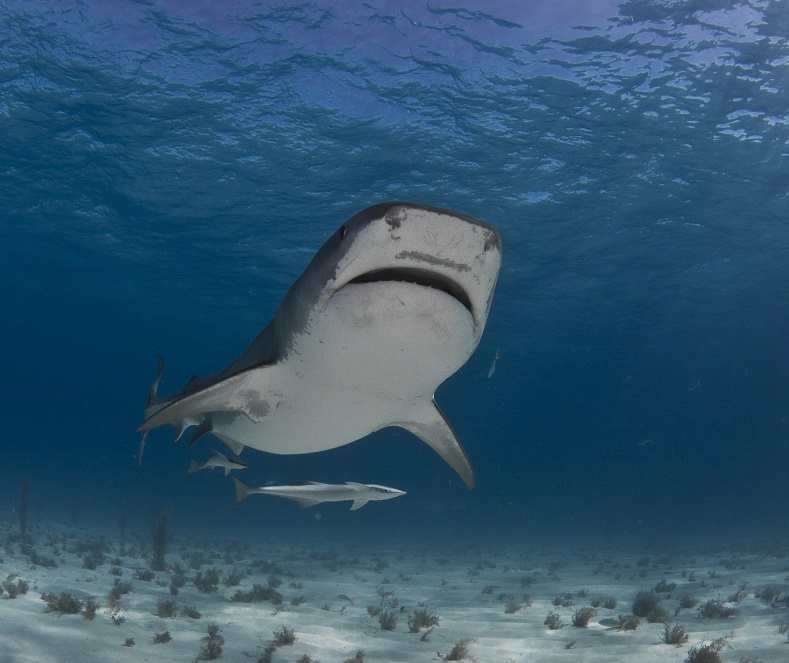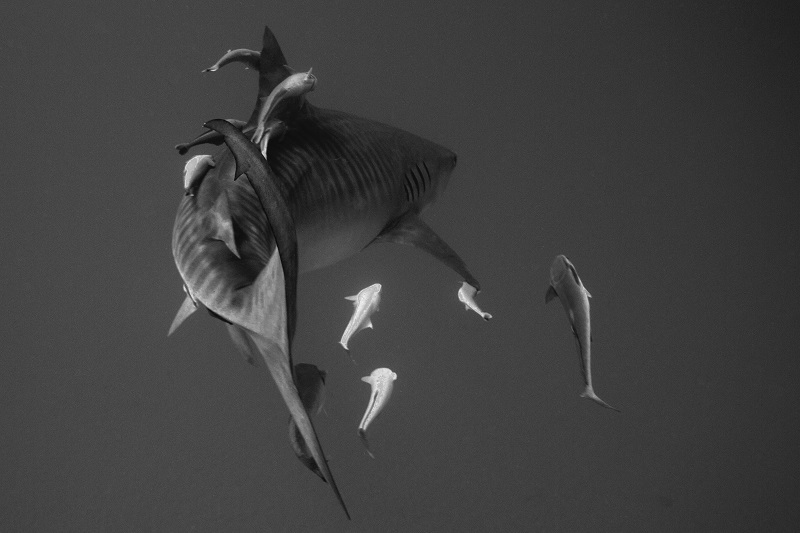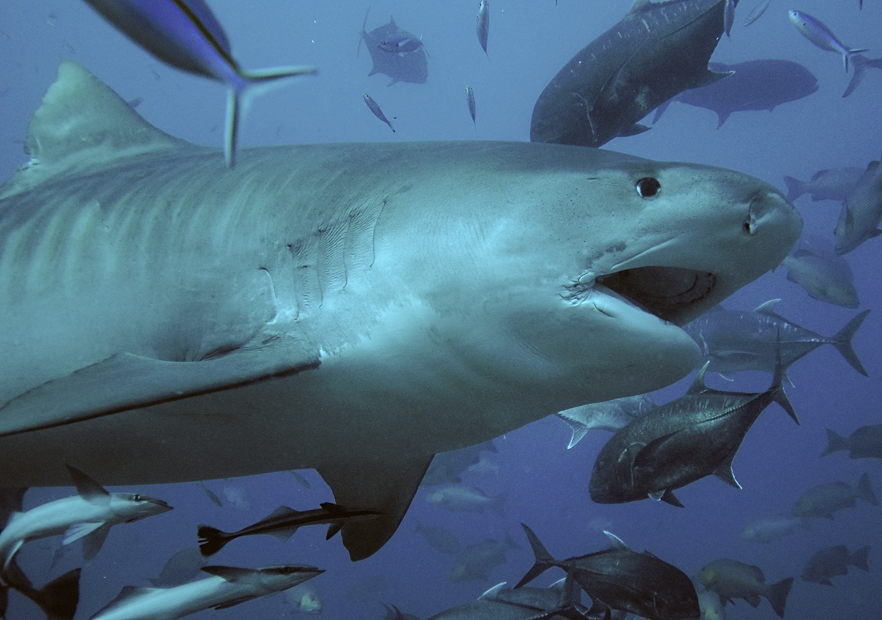Today we return to scuba diving on Tiger Beach, Bahamas, Part 3.

The tiger-like striped pattern, with which the hunter can easily be recognized, fades with age. Divers who encounter a tiger shark should not panic. The dangerous animal is rather shy and reserved toward divers.
As a rule, you can keep the shark in check with a stick or a large camera, but you must have good nerves. In particular, don’t let the shark push you toward the water surface—the so-called death zone. There, the tiger shark loses all inhibitions. The calm and leisurely buoyancy of the massive cartilaginous fish should not conceal the fact that it can achieve an astonishing acceleration and endurance.
Tiger sharks live in coastal waters, but they also regularly cover vast distances.
A team from the Guy Harvey Research Institute of the Nova Southeastern University in Florida found this out. They tagged a total of 24 tiger sharks with satellite transmitters in the Bermuda Islands and followed their migration for three years. They learned the area around the Bermudas is something like a tiger shark highway.
Here the sharks collect their powers and then swim farther north or south. They spend the winter in Caribbean waters (Bermuda, Bahamas, Turks and Caicos Islands, Anguilla) and mate. In the spring, they travel north into the open Atlantic Ocean as high up as Connecticut. During their round trip, some of the marked sharks covered a distance of 7,500 kilometers (4,660 mi).

Tiger sharks will often appear—completely unexpected and, especially, from behind. They are ambush predators. Therefore, the whole dive group should not only keep an eye on the food box, but also ensure a 360-degree check. This becomes even more important as the number of big predators increases at Tiger Beach.
Nevertheless, a close-up encounter with a tiger shark is one of the most exciting things you can experience as a diver. When diving with great white sharks, all participants usually sit in a safe cage.
At Tiger Beach, this is absolutely impossible because of topography. No cage, no safety, just water and sharks. That’s why Tiger Beach is diver’s first choice for tiger sharks.
For centuries tiger sharks were the horror of all sailors. Ten years ago no one could have imagined the fact that one would dive with them—even voluntarily. That changed. It was in the spring of 1998 when Jim Abernethy with his ship Shearwater sought shelter on a sandbank of the Little Bahama Bank on the occasion of a rising storm.
The next morning Abernethy and his crew saw great shadows glide through the turquoise water. A hastily performed dive revealed a small sensation. Five tiger sharks were seen. The precipitous descent ended, fortunately without injury, and Abernethy recognized his chance to create something unique.
That was the birth of Tiger Beach, a shark arena in the waters of the Bahamas. The bottom is fine sand, which can be perceived as floating particles with the presence of divers and sharks in larger numbers. The visibility may be difficult. We were mostly lucky and appreciated it at 20 to 30 meters (66 to 98 ft).
In the afternoon there is a regular current which, although it distributes all truffles, also makes it more difficult to stay seated. The low depth is ideal, because you do not have to worry about your total diving time and can quickly access the boat.
If you should dare to surface quickly, the tiger sharks react immediately and follow one to the platform, sometimes with open mouth. This boosts the adrenaline supply.
Diving with tiger sharks is unquestionably something special. The great predators are rightly regarded as risk factors, because their reactions can never be predicted in every detail. It becomes a gambling game with an uncertain exit—or not. If you can manage the business with the tigers of the sea, everything looks simple and calculable.
But, is it really? A somewhat queasy feeling comes when you slide into the green blue water for the first time. One can only photograph tiger sharks by luring them to the boat with bait boxes, sensibly and largely without danger. If an attractive bait is missing, you might turn into one yourself, and then it could get uncomfortable.
A real attack is hard to survive. Our guide, Martin, has his eyes everywhere, but you have to be alert yourself all the time.
The situation is controllable up to the number of about two to three tiger sharks. With more it becomes critical, because the sharks are also approaching from behind, and they want to examine the divers for feasibility.
When the white naked skin of the shark’s eyes swings upward, extreme caution is required. Then at least a test bite is bound to happen. The biting attempts, although they cannot be considered serious attacks, are nevertheless hellishly dangerous.
The giant, triangular teeth of the tiger shark tears ugly and possibly fatal wounds even in a test bite. Plus one cannot estimate how the lemon sharks swimming in groups will behave with blood in the water, and then there is the trip to the hospital which will be a few hours away by boat.
Even if you survive the bite in the water, the chances of getting away unharmed are bad. That disaster at Tiger Beach is omnipresent is proved by the deadly incidents on Markus Groh and Dr. John Petty!
To ensure the adventure is safely surpassed, Martin has developed his own precautions and rules: The diver’s suit, mask, fins and buoyancy jacket should be covered in dark or pale colors.
Although one is not sure whether tiger sharks can see colors, Martin is of the opinion that everything that is yellow, white, pink or silvery is a no-go, because it might encourage the predator to investigate. I leave my jewelry and my yellow snorkel on board.
I look a bit confused when some of us get neon yellow and aluminum colored scuba tanks!
In addition, we get about 50 cm (20 in) long, cut-off PVC pipes to keep the sharks at a distance.
When it’s my turn to get one, the pipes are out. Great! Instead, Captain Levente puts a 30 cm (20 in) screwdriver with a bright orange handle into my hand. How was that again with the renouncement of bright colors?
Some tiger sharks have been feeding regularly for years and have names like “Emma,” “Hook,” or “Tarantino.” Others come only occasionally.

A critical moment is always the ascent to the boat platform. You should only do it if there is no tiger shark in the immediate vicinity. They always follow to the platform. There were several hairy situations which we could not interpret 100 percent afterward. Would the tiger shark have bitten if he had caught the legs or the fins?
Martin agreed, but was also not sure if the bite would have been conducted with all consistency. Perhaps it would have been just a test, but that would have meant, at the least, a run for the hospital or, perhaps, the casket.
The basic questions are: Why can you, as a diver, usually go safely into the realm of the sharks? And, why are people sometimes attacked?
In field trials with bull sharks in the Bahamas, Dr. Erich Ritter found three criteria must be fulfilled that tempt a shark to attack a human being: 1. The smell 2. The noise 3. The poor visibility.
At the first attempt, Dr. Ritter waded to the sharks in chest deep, clear water and fed them bait. Although the smell of food was in the water, they did not attack him because two other points were not fulfilled: he did not make any noise and there was good visibility.
In the second experiment, he swam between the sharks and caused the sound of a fish in distress. But there was also no attack, as there was still good visibility under water. Had he been swimming in turbid waters, his pale legs might have reminded sharks of the bright belly of a prey, which could have motivated sharks to attack. According to Dr. Ritter, if all three criteria were met, an attack could be triggered.
My time in the Bahamas is coming to an end. I’ve seen a lot of sharks. The Bahamian government has understood that it is worth protecting sharks and making them a good source of income through tourism. They are a lively treat for divers and photographers.

My conclusion? The Bahamas are full of beauty, nature, adventure and good mood. Even in the low season, the islands are a sunny paradise beyond mass tourism. The big sharks like to go through here.
And I, too, will return.
Christian Kemper is a TV journalist from Germany. He has been diving with and studying sharks for more than 20 years. He has written two books about shark attacks and one book about crocodiles. He is a freelance writer for three of the biggest diving magazines in Germany.

You can find his German Language book Strange Pool Friends on Amazon and at tredition.



